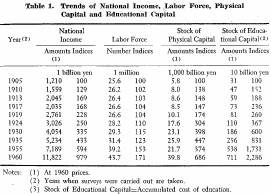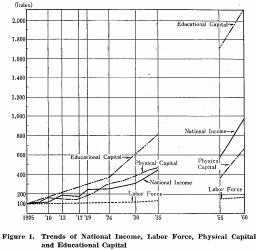| Home > Policy > White Paper, Notice, Announcement > White Paper > JAPAN'S GROWTH AND EDUCATION 1963 > CHAPTER |
||
The relations between human capabilities developed by education and the econmoic development in our country will be presented here in statistical figures. Table l shows the increases in national income, labor force, stock of physuical capital and stock of education capital during the 55 years from 1905 to 1960.


Data are lacking for period between 1935 and 1955, when World
War ![]() caused
a great loss of physical capital. Notwithstanding this defect in the table, the
fo11owing trends are observed.
caused
a great loss of physical capital. Notwithstanding this defect in the table, the
fo11owing trends are observed.
While the labor force of our country had grown from 25.6 million
to 43.7 million, increasing 70 per cent during these 55 years, the stock of physical
capital increased 700 per cent, rising from 5,800 billion yen to 39,800 billion
yen. However, national income had grown at a much higher rate, rising from 1,200
billion yen to 12,000 billion yen, or 1,000 per cent. In contrast to the very
gradual growth of the labor force, the rate of increase of physical capital was
remarkable. During the period between 1924 and 1930, the rate of increase of
physical capital exceeded even the rate of increase of the national income. After
World War ![]() ,
the stock of physical capital had recovered to the pre-War level by around 1955
and its annual rate of increase is still high. However, the average annual rate
of growth of national income was considerably higher than that of physical capital
during the entire 55-year period.
,
the stock of physical capital had recovered to the pre-War level by around 1955
and its annual rate of increase is still high. However, the average annual rate
of growth of national income was considerably higher than that of physical capital
during the entire 55-year period.
That the rate of increase of national income exceeds the rates of increase of physical capital and of labor force, is true not only in Japan but also in most of the industrially developed countries. This is due to the increase in the productivities of physical capital and the labor force, resulting from rapidly effected technological innovation.
The current economic growth in industrially developed countries, as explained above, has been brought about mainly by technical innovation, where the rise of levels of science and technology and their prevalenc are more relevant to the economic growth than mere quantitative increase of physical capital and labor force.
Modern industries can develop at a much higher rate only when there are available those people who create the more productive physical facilities, those who opperate these facilities and those who have the abilities of organization and management to combine efficiently these physical facilities and labor force. This is the reason why the factor of human capabilities is being given such stress as never before. In consequence of the profound recognition of this situation by economists, modern economics theory often indentifies the new factor in production as 'human capital', separate from physical capital and labor. It should therefore be positively intended to increase the stock of 'human capital': in other words, efforts should be directed to raise the levels of human capabilities, if this factor is to make more. contribution to the increase of production. And the most important factor to raise the level of human capabilities is assumed to be education. The quantitative development of education inevitably entails more cost. Accordingly, the cost of educational development might be looked upon as the investment in people engaged in production. In this context, we might term the educational cost as 'investment in education' or 'educational investment' and the accumulated cost of education as the 'stock of education capital'.
As investment in education is accumulated as the stock of capabilities possessed by the people educated, the stock of educational capital is the total stock of education valued at cost, possessed by the labor force. This means that the stock of educational capital shows the distribution of education among the labor force valued at cost.
The stock of educational capital in Japan is estimated in 1960 at about 7,100 billion yen and this amounts to 161,O00 yen per laborer. The stock of educational capital in 1960 is 23 times of that in 1905, which amounted to 310 billion yen. The rate of increase of the stock of educational capital was the highest, compared to the rates of increase of the labor force, of the stock of physical capital and even of national income, through the 55 years. Furthermore, the rate of increase of the stock of educational capital always exceeded the rates of increase of such other factors.
However, whereas the stock of physical capital was valued at 39,800 billion yen in 1960, the value of the stock of educational capital was estimated at 7,100 billion yen, which is only 18 per cent of the stock of physical capital.
It should be noted that the rates of increase of the stock of physical capital and of the stock of educational capital change age by age. During the 12 years from 1905 to 1917, the stock of physical capital increased 47 percent, while the stock of educational capital increased 136 per cent. Between 1917 and 1935, the stock of physical capital had grown about 3 times and the stock of educational capital increased about 3.5 times. But during the recent 5 years from 1955 to 1960, whereas the stock of physical capital increased 83 per cent, the rate of increase of the stock of educational capital was only 32 per cent.
Serious attention should be paid to the fact that the rate of educational investment is decreasing in our country at a time when educational investment is being recognized as a very productive investment and most of the developed countries are striving to increase their educational investment.
| Back to Top | MEXT HOME |